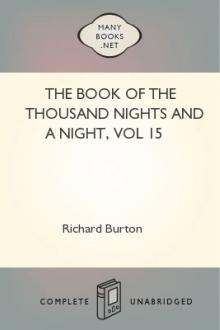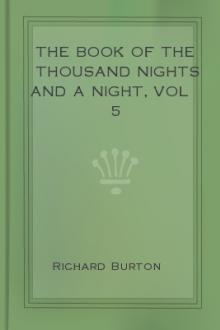The Book of the Thousand Nights and a Night, vol 6 by Sir Richard Francis Burton (best novels for students txt) 📖

- Author: Sir Richard Francis Burton
- Performer: -
Book online «The Book of the Thousand Nights and a Night, vol 6 by Sir Richard Francis Burton (best novels for students txt) 📖». Author Sir Richard Francis Burton
[FN#103] “Tusks” not “teeth” which are not valued. As Hole remarks, the elephants of Pliny and Sindbad are equally conscious of the value of ivory. Pliny (viii. 3) quotes Herodotus about the buying of ivories and relates how elephants, when hunted, break their “cornua” (as Juba called them) against a tree trunk by way of ransom. �lian, Plutarch, and Philostratus speak of the linguistic intelligence and religious worship of the “half-reason with the hand,” which the Hindus term “H�th�”=unimanus. Finally, Topsell’s Gesner (p. 152) makes elephants bury their tusks, “which commonly drop out every tenth year.” In Arabian literature the elephant is always connected with India.
[FN#104] This is a true “City of Brass.” (Nuh�s asfar=yellow copper), as we learn in Night dcclxxii. It is situated in the “Maghrib” (Mauritania), the region of magic and mystery; and the idea was probably suggested by the grand Roman ruins which rise abruptly from what has become a sandy waste. Compare with this tale “The City of Brass” (Night cclxxii.). In Egypt Nuh�s is vulg. pronounced Nih�s.
[FN#105] The Bresl. Edit. adds that the seal-ring was of stamped stone and iron, copper and lead. I have borrowed copiously from its vol. vi. pp. 343, et seq.
[FN#106] As this was a well-known pre-Islamitic bard, his appearance here is decidedly anachronistic, probably by intention.
[FN#107] The first Moslem conqueror of Spain whose lieutenant, T�rik, the gallant and unfortunate, named Gibraltar (Jabal al-Tarik).
[FN#108] The colours of the Ban� Umayyah (Ommiade) Caliphs were white, of the Ban� Abb�s (Abbasides) black, and of the Fatimites green. Carrying the royal flag denoted the generalissimo or plenipotentiary.
[FN#109] i.e. Old Cairo, or Fustat: the present Cairo was then a Coptic village founded on an old Egyptian settlement called Lui-Tkeshroma, to which belonged the tanks on the hill and the great well, Bir Yusuf, absurdly attributed to Joseph the Patriarch. Lui is evidently the origin of Levi and means a high priest (Brugsh ii. 130) and his son’s name was Roma.
[FN#110] I cannot but suspect that this is a clerical error for “Al-Samanh�di,” a native of Samanh�d (Wilkinson’s “Semenood”) in the Delta on the Damietta branch, the old Sebennytus (in Coptic Jem-nuti=Jem the God), a town which has produced many distinguished men in Moslem times. But there is also a Samh�d lying a few miles down stream from Denderah and, as its mounds prove, it is an ancient site.
[FN#111] Egypt had not then been conquered from the Christians.
[FN#112] Arab. “K�z�n fukk�‘a,” i.e. thin and slightly porous earthenware jars used for Fukk�‘a, a fermented drink, made of barley or raisins.
[FN#113] I retain this venerable blunder: the right form is Sam�m, from Samm, the poison-wind.
[FN#114] i.e. for worship and to prepare for futurity.
[FN#115] The camel carries the Badawi’s corpse to the cemetery which is often distant: hence to dream of a camel is an omen of death.
[FN#116] Koran xxiv 39. The word “Sar�b” (mirage) is found in Isaiah (xxxv. 7) where the passage should be rendered “And the mirage (sharab) shall become a lake” (not, “and the parched ground shall become a pool”). The Hindus prettily call it “Mrigatrishn�” = the thirst of the deer.
[FN#117] A name of Allah.
[FN#118] Arab. “Kint�r”=a hundredweight (i.e. 100 Ibs.), about 98
3/4 Ibs. avoir. Hence the French quintal and its congeners (Littr�).
[FN#119] i.e. “from Sh�m (Syria) to (the land of) Adnan,”
ancestor of the Naturalized Arabs that is, to Arabia.
[FN#120] Koran lii. 21. “Every man is given in pledge for that which he shall have wrought.”
[FN#121] There is a constant clerical confusion in the texts between “Arar” (Juniperus Oxycedrus used by the Breeks for the images of their gods) and “Marmar” marble or alabaster, in the Talmud “Marmora” = marble. evidently from {Greek letters} =
brilliant, the brilliant stone.
[FN#122] These Ifritical names are chosed for their bizarrerie.
“Al-D�hish” = the Amazed; and “Al-A’amash” = one with weak eyes always watering.
[FN#123] The Arabs have no word for million; so Messer Marco Miglione could not have learned it from them. On the other hand the Hindus have more quadrillions than modern Europe.
[FN#124] This formula, according to Moslems, would begin with the beginning “There is no il�h but Allah and Adam is the Apostle (ras�l = one sent, a messenger, not nab� = prophet) of Allah.”
And so on with Noah, Moses, David (not Solomon as a rule) and Jesus, to Mohammed.
[FN#125] This son of Barachia has been noticed before. The text embroiders the Koranic chapter No. xxvii.
[FN#126] The Bresl. Edit. (vi. 371) reads “Samm-hu”=his poison, prob. a clerical error for “Sahmhu”=his shaft. It was a duel with the “Shih�b” or falling stars, the meteors which are popularly supposed, I have said, to be the arrows shot by the angels against devils and evil spirits when they approach too near Heaven in order to overhear divine secrets.
[FN#127] A fancy sea from the Lat. “Carcer” ( ?).
[FN#128] Andalusian = Spanish, the Vandal-land, a term accepted by the Moslem invader.
[FN#129] This fine description will remind the traveller of the old Haurani towns deserted since the sixth century, which a silly writer miscalled the “Giant Cities of Bashan.” I have never seen anything weirder than a moonlight night in one of these strong places whose masonry is perfect as when first built, the snowy light pouring on the jet-black basalt and the breeze sighing and the jackal wailing in the desert around.
[FN#130] “Zanj,” I have said, is the Arab. form of the Persian “Zang-bar” (=Black-land), our Zanzibar. Those who would know more of the etymology will consult my “Zanzibar,” etc., chaps. i.
[FN#131] Arab. “Tanjah”=Strabo {Greek letters} (derivation uncertain), Tingitania, Tangiers. But why the terminal s ?
[FN#132] Or Amidah, by the Turks called “Kara (black) Amid” from the colour of the stones and the Arabs “Diyar-bakr” (Diarbekir), a name which they also give to the whole province—Mesopotamia.
[FN#133] Mayy�f�rik�n, an episcopal city in Diyar-bakr: the natives are called F�rik�; hence the abbreviation in the text.
[FN#134] Arab. “Ay�t al-Naj�t,” certain Koranic verses which act as talismans, such as, “And wherefore should we not put our trust in Allah ?” (xiv. 15); “Say thou, �Naught shall befall us save what Allah hath decreed for us,’ ” (ix. 51), and sundry others.
[FN#135] These were the “Brides of the Treasure,” alluded to in the story of Hasan of Bassorah and elsewhere.
[FN#136] Arab. “Ish�rah,” which may also mean beckoning. Easterns reverse our process: we wave hand or finger towards ourselves; they towards the object; and our fashion represents to them, Go away!
[FN#137] i.e. musing a long time and a longsome.
[FN#138] Arab. “Dihl�z” from the Persian. This is the long dark passage which leads to the inner or main gate of an Eastern city, and which is built up before a siege. It is usually furnished with Mastabah-benches of wood and masonry, and forms a favourite lounge in hot weather. Hence Lot and Moses sat and stood in the gate, and here man speaks with his enemies.
[FN#139] The names of colours are as loosely used by the Arabs as by the Classics of Europe; for instance, a light grey is called a “blue or a green horse.” Much nonsense has been written upon the colours in Homer by men who imagine that the semi-civilised determine tints as we do. They see them but they do not name them, having no occasion for the words. As I have noticed, however, the Arabs have a complete terminology for the varieties of horse-hues. In our day we have witnessed the birth of colours, named by the dozen, because required by women’s dress.
[FN#140] For David’s miracles of metallurgy see vol. i. 286.
[FN#141] Arab. “Khw�razm,” the land of the Chorasmioi, who are mentioned by Herodotus (iii. 93) and a host of classical geographers. They place it in Sogdiana (hod. Sughd) and it corresponds with the Khiva country.
[FN#142] Arab. “Burka’,” usually applied to a woman’s face-veil and hence to the covering of the Ka’abah, which is the “Bride of Meccah.”
[FN#143] Alluding to the trick played upon Bilk�s by Solomon who had heard that her legs were hairy like those of an ass: he laid down a pavement of glass over flowing water in which fish were swimming and thus she raised her skirts as she approached him and he saw that the report was true. Hence, as I have said, the depilatory.
[FN#144] I understand the curiously carved windows cut in arabesque-work of marble. (India) or basalt (the Haur�n) and provided with small panes of glass set in emeralds where tin would be used by the vulgar.
[FN#145] Arab. “Bul�d” from the Pers. “Pul�d.” Hence the name of the famous Druze family “Jumblat,” a corruption of “J�n-pul�d”=Life o’ Steel.
[FN#146] Pharaoh, so called in Koran (xxxviii. 11) because he tortured men by fastening them to four stakes driven into the ground. Sale translates “the contriver of the stakes” and adds, “Some understand the word figuratively, of the firm establishment of Pharaoh’s kingdom, because the Arabs fix their tents with stakes; but they may possibly intend that prince’s obstinacy and hardness of heart.” I may note that in “Tasawwuf,” or Moslem Gnosticism, Pharaoh represents, like Prometheus and Job, the typical creature who upholds his own dignity and rights in presence and despight of the Creator. S�hib the S�f� declares that the secret of man’s soul (i.e. its emanation) was first revealed when Pharaoh declared himself god; and Al-Ghaz�l� sees in his claim the most noble aspiration to the divine, innate in the human spirit. (Dabistan, vol. iii.) [FN#147] In the Calc. Edit. “Tarmuz, son of the daughter,” etc.
According to the Arabs Tadmur (Palmyra) was built by Queen Tadmurah, daughter of Hass�n bin Uzaynah.
[FN#148] It is only by some such drought that I can account for the survival of those marvellous Haurani cities in the great valley S. E. of Damascus.
[FN#149] So Moses described his own death and burial.
[FN#150] A man’s “aurat” (shame) extends from the navel (included) to his knees, a woman’s from the top of the head to the tips of her toes. I have before noticed the Hindostan�
application of the word.
[FN#151] Arab. “Jum’ah” ( = the assembly) so called because the General Resurrection will take place on that day and it witnessed the creation of Adam. Both these reasons are evidently after-thoughts; as the Jews received a divine order to keep Saturday, and the Christians, at their own sweet will, transferred the weekly rest-day to Sunday, wherefore the Moslem preferred Friday.
Sabbatarianism, however, is unknown to Al-Islam and business is interrupted, by Koranic order ([xii. 9-10), only during congregational prayers in the Mosque. The most a Mohammedan does is not to work or travel till after public service. But the Moslem hardly wants a “day of rest;” whereas a Christian, especially in the desperately dull routine of daily life and toil, without a gleam of light to break the darkness of his civilised and most unhappy existence, disctinctly requires it.
[FN#152] Mankind, which sees itself everywhere and in everything, must create its own analogues in all the elements, air (Sylphs), fire (Jinns), water (Mermen and Mermaids) and earth (Kobolds), These merwomen were of course seals or manatees, as the wild women of Hanno were gorillas.
[FN#153] Here begins the Sindibad-namah, the origin of Dolopathos (thirteenth century by the Trouv�re Harbers); of the “Seven Sages”





Comments (0)